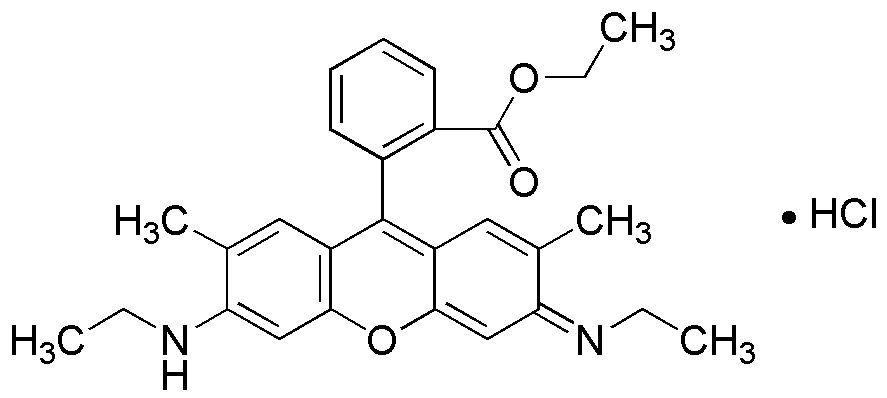Rhodamine 6G is widely utilized in research focused on:
- Fluorescent Dyes: Commonly used as a fluorescent marker in biological and chemical research, enabling visualization of cellular processes under fluorescence microscopy.
- Laser Technology: Employed in dye lasers, providing high efficiency and stability, making it ideal for applications in spectroscopy and medical diagnostics.
- Environmental Monitoring: Acts as a tracer dye in hydrological studies to track water flow and contamination, helping researchers assess water quality and ecosystem health.
- Textile Industry: Utilized as a dye for fabrics, offering vibrant colors and excellent lightfastness, which is crucial for producing long-lasting textiles.
- Photodynamic Therapy: Investigated for its potential in cancer treatment, where it can be activated by light to produce reactive oxygen species that selectively kill cancer cells.
General Information
Properties
Safety and Regulations
Applications
Rhodamine 6G is widely utilized in research focused on:
- Fluorescent Dyes: Commonly used as a fluorescent marker in biological and chemical research, enabling visualization of cellular processes under fluorescence microscopy.
- Laser Technology: Employed in dye lasers, providing high efficiency and stability, making it ideal for applications in spectroscopy and medical diagnostics.
- Environmental Monitoring: Acts as a tracer dye in hydrological studies to track water flow and contamination, helping researchers assess water quality and ecosystem health.
- Textile Industry: Utilized as a dye for fabrics, offering vibrant colors and excellent lightfastness, which is crucial for producing long-lasting textiles.
- Photodynamic Therapy: Investigated for its potential in cancer treatment, where it can be activated by light to produce reactive oxygen species that selectively kill cancer cells.
Documents
Safety Data Sheets (SDS)
The SDS provides comprehensive safety information on handling, storage, and disposal of the product.
Product Specification (PS)
The PS provides a comprehensive breakdown of the product’s properties, including chemical composition, physical state, purity, and storage requirements. It also details acceptable quality ranges and the product's intended applications.
Certificates of Analysis (COA)
Search for Certificates of Analysis (COA) by entering the products Lot Number. Lot and Batch Numbers can be found on a product’s label following the words ‘Lot’ or ‘Batch’.
Numéro de catalogue
Numéro de lot/série
Certificates Of Origin (COO)
This COO confirms the country where the product was manufactured, and also details the materials and components used in it and whether it is derived from natural, synthetic, or other specific sources. This certificate may be required for customs, trade, and regulatory compliance.
Numéro de catalogue
Numéro de lot/série
Safety Data Sheets (SDS)
The SDS provides comprehensive safety information on handling, storage, and disposal of the product.
DownloadProduct Specification (PS)
The PS provides a comprehensive breakdown of the product’s properties, including chemical composition, physical state, purity, and storage requirements. It also details acceptable quality ranges and the product's intended applications.
DownloadCertificates of Analysis (COA)
Search for Certificates of Analysis (COA) by entering the products Lot Number. Lot and Batch Numbers can be found on a product’s label following the words ‘Lot’ or ‘Batch’.
Numéro de catalogue
Numéro de lot/série
Certificates Of Origin (COO)
This COO confirms the country where the product was manufactured, and also details the materials and components used in it and whether it is derived from natural, synthetic, or other specific sources. This certificate may be required for customs, trade, and regulatory compliance.


